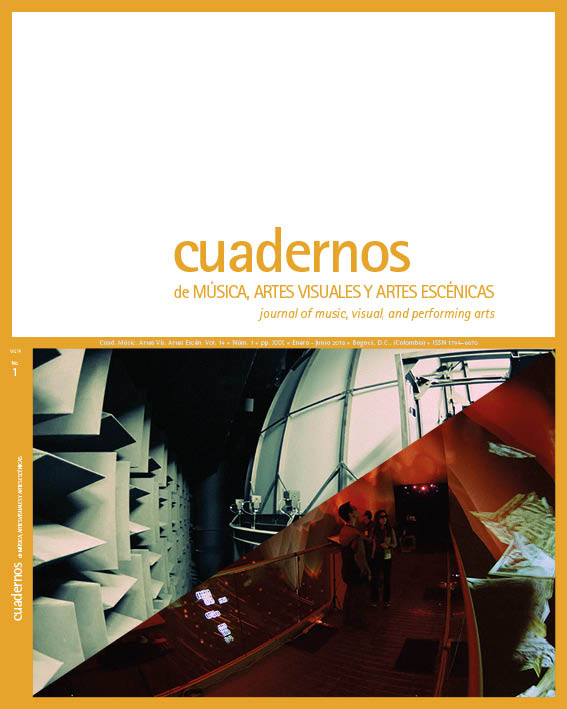Resumen
Este artículo pretende ser una aproximación analítico-reflexiva de la función del intérprete musical en el campo de la música contemporánea y experimental hoy en día. Desde sus orígenes y desde el momento en que el intérprete se desligó de la figura del compositor, sus funciones y maneras de abordar la música, su estudio e interpretación han ido variando. Estas variaciones, sin embargo, siguen estrechamente vinculadas a los cambios de corrientes y visiones compositivas y de cómo estas definen los conceptos de idea musical, proceso creativo o resultado sonoro. El término utilizado para describir a este nuevo tipo de intérprete, extended performer, se refiere a cómo esta función se ha extendido, expandido, más allá de los límites de una práctica instrumental o performativa. Perfilando los orígenes históricos del intérprete musical y pasando por los cambios de paradigma que sucedieron durante el siglo XX con las diferentes corrientes vanguardistas y con nombres propios, tales como John Cage o Pierre Boulez, llegaremos al citado extended performer actual, ejemplificando esta nueva figura a través de movimientos compositivos actuales, la importancia de la digitalización en el arte y cómo esta ha planteado una nueva relación entre el intérprete y su instrumento.
Cage, John. 1973. Silence. Hanover: Wesleyan University Press.
Danuser, Hermann. 2016. “Interpretación”. Revista de Musicología 39 (1): 19-45. DOI: 10.2307/24878536.
Echeverría, Bolívar. 2003. Introducción a La obra de arte en la época de su reproductibilidad técnica, de
Walter Benjamin, 9-28, México: Itaca.
Erwin, Max. 2016. “Here comes Newer Despair: An Aesthetic Primer for the New Conceptualism of
Johannes Kreidler”. Tempo 70 (278): 5-15. https://www.cambridge.org/core/journals/tempo/article/
here-comes-newer-despair-an-aesthetic-primer-for-the-new-conceptualism-of-johannes-kreidler/156
3136B03BB2DBD63CB264D12D6F572.
Fernández Guerra, Jorge. 1985. Pierre Boulez. Madrid: Círculo de Bellas Artes.
Fuhrmann, Wolfgang. 2011. “Toward a Theory of Socio-Musical Systems: Reflections on Niklas Luhmann’s
Challenge to Music Sociology”. Acta Musicologica 83 (1): 135-159.
Gadamer, Hans-Georg. 1996. Estética y hermenéutica. Madrid: Tecnos.
Gottstein, Björn. 2011. “Digitalisierung und Musik / ein (Streit-) gespräch zwischen Claus-Steffen Mahnkopf
und Johannes Kreidler ; moderiert von Björn Gottstein”. Musik Texte Köln 128.
Hegel, Georg W. Friedrich. 1985. Estética: la pintura y la música. Buenos Aires: Siglo XXI.
“Interpretar”. 2014. Diccionario de la lengua española. http://dle.rae.es/?id=LwUON38.
Kreidler, Johannes. 2009. “Fremdarbeit”. https://www.youtube.com/watch?v=L72d_0zIT0c&feature=youtu.be.
— 2011. Musik mit Musik: Texte 2005-2011. Múnich: Volke-Verlag.
Kreidler, Johannes, Harry Lehmann y Claus-Steffen Mahnkopf. 2010. Musik, Ästhetik, Digitalisierung: Eine
Kontroverse. Hofheim: Wolke.
“minusBolero”. 2015. Kreidler-net. http://www.kreidler-net.de/theorie/minusbolero.pdf.
Nelson, Peter. 1999. “El cyborg musical”. En Música y nuevas tecnologías: perspectivas para el siglo XXI,
de Eduardo Reck Miranda, 69-83. Barcelona: L’Angelot.
Pardo Salgado, Carmen. 1999. “Interpret/acción”. Contrastes: Revista Internacional de Filosofía 4: 135-148.
DOI: http://dx.doi.org/10.24310/Contrastescontrastes.v0i0.1508
— 2014. La escucha oblicua: una invitación a John Cage. Madrid: Ensayo Sexto Piso.
Rivière Ríos, Henar. 2011. “Papeles para la historia de Fluxus y Zaj: entre el documento y la práctica
artística”. Anales de Historia del Arte, Volumen Extraordinario: 421-436.
“Stefan Prins”. 2012. Stefanprins.be. http://www.stefanprins.be/eng/composesChrono/comp_2012_03.html
Stravinsky, Igor. 2006. Poética musical. Barcelona: Acantilado.
Esta revista científica se encuentra registrada bajo la licencia Creative Commons Reconocimiento 4.0 Internacional. Por lo tanto, esta obra se puede reproducir, distribuir y comunicar públicamente en formato digital, siempre que se reconozca el nombre de los autores y a la Pontificia Universidad Javeriana. Se permite citar, adaptar, transformar, autoarchivar, republicar y crear a partir del material, para cualquier finalidad, siempre que se reconozca adecuadamente la autoría, se proporcione un enlace a la obra original y se indique si se han realizado cambios. La Pontificia Universidad Javeriana no retiene los derechos sobre las obras publicadas y los contenidos son responsabilidad exclusiva de los autores, quienes conservan sus derechos morales, intelectuales, de privacidad y publicidad.
El aval sobre la intervención de la obra (revisión, corrección de estilo, traducción, diagramación) y su posterior divulgación se otorga mediante una licencia de uso y no a través de una cesión de derechos, lo que representa que la revista y la Pontificia Universidad Javeriana se eximen de cualquier responsabilidad que se pueda derivar de una mala práctica ética por parte de los autores. Como consecuencia de la protección brindada por la licencia de uso, la revista puede publicar retractaciones o corregir la información ya publicada. La publicación de contenidos en esta revista no representa regalías para los contribuyentes.



